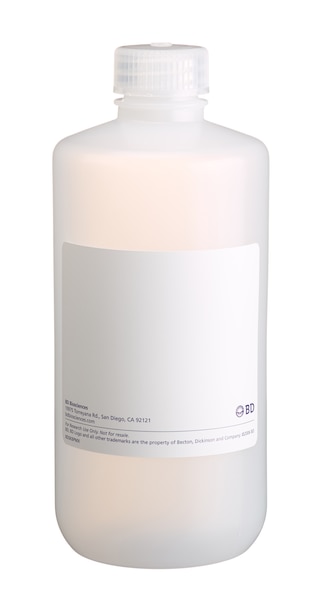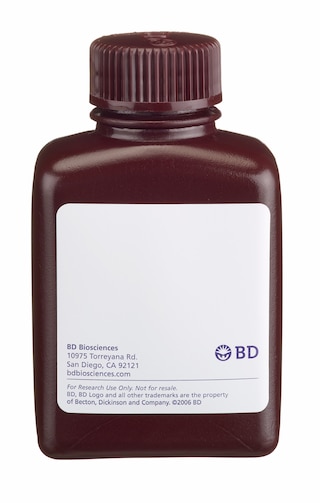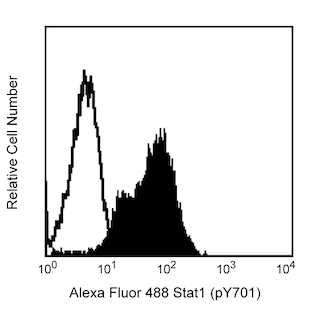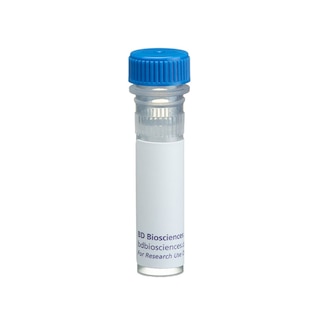Old Browser
Looks like you're visiting us from United States.
Would you like to stay on the current country site or be switched to your country?
BD Transduction Laboratories™ Purified Mouse Anti-CDC5L
克隆 21/CDC5L (RUO)

Left: Western blot analysis of CDC5L on a rat cerebrum lysate. Lane 1: 1:5000, lane 2: 1:10000, lane 3: 1:20000 dilution of the CDC5L antibody. Right: Immunofluorescent staining of U-2 OS (ATCC HTB-96) cells. Cells were seeded in a 96 well imaging plate (Cat. No. 353219) at ~ 10 000 cells per well. After overnight incubation, cells were stained using the alcohol perm protocol and the anti-CDC5L antibody. The second step reagent was FITC goat anti mouse Ig (Cat. No. 554001). Images were taken on a BD Pathway™ 855 bioimaging system using a 20x objective. This antibody also stained HeLa (ATCC CCL-2) cells and worked with both the Triton™ X-100 and alcohol perm protocols (see Recommended Assay Procedure). This antibody is not recommended for staining A549 cells.


Left: Western blot analysis of CDC5L on a rat cerebrum lysate. Lane 1: 1:5000, lane 2: 1:10000, lane 3: 1:20000 dilution of the CDC5L antibody. Right: Immunofluorescent staining of U-2 OS (ATCC HTB-96) cells. Cells were seeded in a 96 well imaging plate (Cat. No. 353219) at ~ 10 000 cells per well. After overnight incubation, cells were stained using the alcohol perm protocol and the anti-CDC5L antibody. The second step reagent was FITC goat anti mouse Ig (Cat. No. 554001). Images were taken on a BD Pathway™ 855 bioimaging system using a 20x objective. This antibody also stained HeLa (ATCC CCL-2) cells and worked with both the Triton™ X-100 and alcohol perm protocols (see Recommended Assay Procedure). This antibody is not recommended for staining A549 cells.

Left: Western blot analysis of CDC5L on a rat cerebrum lysate. Lane 1: 1:5000, lane 2: 1:10000, lane 3: 1:20000 dilution of the CDC5L antibody. Right: Immunofluorescent staining of U-2 OS (ATCC HTB-96) cells. Cells were seeded in a 96 well imaging plate (Cat. No. 353219) at ~ 10 000 cells per well. After overnight incubation, cells were stained using the alcohol perm protocol and the anti-CDC5L antibody. The second step reagent was FITC goat anti mouse Ig (Cat. No. 554001). Images were taken on a BD Pathway™ 855 bioimaging system using a 20x objective. This antibody also stained HeLa (ATCC CCL-2) cells and worked with both the Triton™ X-100 and alcohol perm protocols (see Recommended Assay Procedure). This antibody is not recommended for staining A549 cells.


BD Transduction Laboratories™ Purified Mouse Anti-CDC5L

监管状态图例
未经BD明确书面授权,严禁使用未经许可的任何商品。
准备和存储
推荐的实验流程
Bioimaging
1. Seed the cells in appropriate culture medium at ~10,000 cells per well in a BD Falcon™ 96-well Imaging Plate (Cat. No. 353219) and culture overnight.
2. Remove the culture medium from the wells, and fix the cells by adding 100 μl of BD Cytofix™ Fixation Buffer (Cat. No. 554655) to each well. Incubate for 10 minutes at room temperature (RT).
3. Remove the fixative from the wells, and permeabilize the cells using either BD Perm Buffer III, 90% methanol, or Triton™ X-100:
a. Add 100 μl of -20°C 90% methanol or Perm Buffer III (Cat. No. 558050) to each well and incubate for 5 minutes at RT.
OR
b. Add 100 μl of 0.1% Triton™ X-100 to each well and incubate for 5 minutes at RT.
4. Remove the permeabilization buffer, and wash the wells twice with 100 μl of 1× PBS.
5. Remove the PBS, and block the cells by adding 100 μl of BD Pharmingen™ Stain Buffer (FBS) (Cat. No. 554656) to each well. Incubate for 30 minutes at RT.
6. Remove the blocking buffer and add 50 μl of the optimally titrated primary antibody (diluted in Stain Buffer) to each well, and incubate for 1 hour at RT.
7. Remove the primary antibody, and wash the wells three times with 100 μl of 1× PBS.
8. Remove the PBS, and add the second step reagent at its optimally titrated concentration in 50 μl to each well, and incubate in the dark for 1 hour at RT.
9. Remove the second step reagent, and wash the wells three times with 100 μl of 1× PBS.
10. Remove the PBS, and counter-stain the nuclei by adding 200 μl per well of 2 μg/ml Hoechst 33342 (e.g., Sigma-Aldrich Cat. No. B2261) in 1× PBS to each well at least 15 minutes before imaging.
11. View and analyze the cells on an appropriate imaging instrument.
Bioimaging: For more detailed information please refer to http://www.bdbiosciences.com/support/resources/protocols/ceritifed_reagents.jsp
Western blot: For more detailed information please refer to http://www.bdbiosciences.com/support/resources/protocols/monoclonal_anti.jsp
商品通知
- Since applications vary, each investigator should titrate the reagent to obtain optimal results.
- This antibody has been developed and certified for the bioimaging application. However, a routine bioimaging test is not performed on every lot. Researchers are encouraged to titrate the reagent for optimal performance.
- Triton is a trademark of the Dow Chemical Company.
- Source of all serum proteins is from USDA inspected abattoirs located in the United States.
- Caution: Sodium azide yields highly toxic hydrazoic acid under acidic conditions. Dilute azide compounds in running water before discarding to avoid accumulation of potentially explosive deposits in plumbing.
- Please refer to www.bdbiosciences.com/us/s/resources for technical protocols.
数据表
配套商品




.png?imwidth=320)
Splicing, the removal of introns from pre-mRNA, is mediated by spliceosomal complexes and occurs in two distinct catalytic steps. The first step involves cleavage of the 5' exon and the production of a lariat intermediate. In the second step, the 3'-splice site is cleaved and the exons are fused with concomitant release of the intron lariat. The spliceosome contains multiple snRNPs and a number of non-snRNP splicing factors. CDC5L is a non-snRNP component of the splicesome that is homologous to the yeast Cdc5 protein. The sequence for CDC5L contgains a helix-turn-helix DNA binding domain (DBD), four nuclear localization signals, and a hydrophilic, proline-rich central region that is similar to the transcriptional activating domain in Myb family transcription factors. CDC5L can interact with the nuclear PP1 inhibitor NIPP-1 and the WD40 domain protein PLRG1. Both of these interactions are critical for pre-mRNA splicing and may also be important for G 2/M phase transition. In addition, CDC5L translocates from the cytoplasm to the nucleus in the presence of serum. Thus, CDC5L localization and splicesome-regulating activity may be controlled by mitogen-activated signal transduction pathways.
研发参考 (4)
-
Ajuh P, Kuster B, Panov K, Zomerdijk JC, Mann M, Lamond AI. Functional analysis of the human CDC5L complex and identification of its components by mass spectrometry. EMBO J. 2000; 19(23):6569-6581. (Biology). 查看参考
-
Ajuh P, Sleeman J, Chusainow J, Lamond AI. A direct interaction between the carboxyl-terminal region of CDC5L and the WD40 domain of PLRG1 is essential for pre-mRNA splicing. J Biol Chem. 2001; 276(45):42370-42381. (Biology). 查看参考
-
Bernstein HS, Coughlin SR. Pombe Cdc5-related protein. A putative human transcription factor implicated in mitogen-activated signaling. J Biol Chem. 1997; 272(9):5833-5837. (Biology). 查看参考
-
Boudrez A, Beullens M, Groenen P, et al. NIPP1-mediated interaction of protein phosphatase-1 with CDC5L, a regulator of pre-mRNA splicing and mitotic entry. J Biol Chem. 2000; 275(33):25411-25417. (Biology). 查看参考
Please refer to Support Documents for Quality Certificates
Global - Refer to manufacturer's instructions for use and related User Manuals and Technical data sheets before using this products as described
Comparisons, where applicable, are made against older BD Technology, manual methods or are general performance claims. Comparisons are not made against non-BD technologies, unless otherwise noted.
For Research Use Only. Not for use in diagnostic or therapeutic procedures.